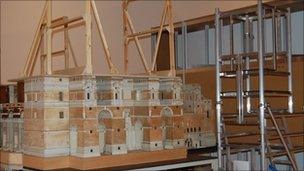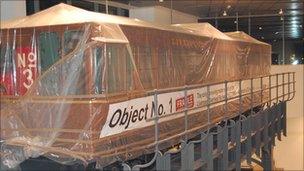Liverpool's 'tremendous biography needs to be told'
- Published

The Museum of Liverpool is due to open in July
"In this city of all cities, the biography needs to be written. It is a tremendous place, with tremendous stories," David Fleming, the director of National Museums Liverpool said.
But instead of penning a biography, Dr Fleming and a team of staff have created a £72m museum, on Liverpool's Pier Head.
The building - which spans 8,000 square metres over three floors - is due to open in July, the museum confirmed earlier this week.
So, how did Liverpool get to have a three-dimensional biography, unlike most other UK cities?
It dates back to 2001, when the city had a competition for a new building near the waterfront and asked National Museums Liverpool (NML) for their input.
'Runt of the litter'
Although the competition eventually fell through, it planted a seed in the minds of staff that a new museum could be built, replacing the popular but dated Museum of Liverpool Life.
"We ran this group of fantastic world class museums but this one museum was the runt of the litter," Dr Fleming said.
"Liverpool is far more important than just being the runt of the litter.

Staff are rebuilding the model of Sir Edwin Lutyens' design for a catholic cathedral, which was never built
"You have this story of it not being very much, to becoming the greatest port the empire had ever seen, to becoming a place where nobody had a job in the 60s, 70s, and 90s, to what it is now."
They started with the museum's shell - drawing up plans with an architect, seeking planning permission and trying to secure vital funding.
A turning point came when the North West Development Agency agreed to provide £35m.
"That's when we knew it was going to happen," Dr Fleming said.
The European Regional Development Fund, the Heritage Lottery Fund and the Department of Culture, Media and Sport also contributed.
NML eventually got planning permission from Liverpool City Council in 2006, after "jumping through hoops", Dr Fleming said.
6,000 items
They broke ground soon afterwards and started to build in 2008 - the city's European Capital of Culture year.
But the museum was not without controversy with people disagreeing about the use of the space on the waterfront, arguing a bandstand or arena would be more popular.

The last remaining motorcar from the Liverpool Overhead Railway has been restored
And the building itself proved problematic, with criticism of the shape, the height and even the marble tile cladding.
Last February, the museum had to pay out £750,000 as the museum blocked the view from the Port of Liverpool building.
By the spring, hundreds of people were working on building the four main galleries - The Great Port, Wondrous Place, People's Republic and Global City - and a tailor-made children's area called Little Liverpool.
But the plans for the interior, and the process of hand picking the 6,000 objects to display, have been in the making for about nine years.
"We have been doing research for years, to illustrate the city's story with objects," Dr Fleming said.
Among the objects are the last remaining motorcar from the Liverpool Overhead Railway, to a model of Sir Edwin Lutyens' design for Liverpool's catholic cathedral, which was never built.
'Normal living'
But Dr Fleming is keen to stress the museum tells the whole story of the city.
Its success stories - including including the Beatles, Liverpool FC and Everton - will be celebrated.
"It's not just about the success and wealth, it's about normal living.
"You have to get beyond the surface of the glass of the city to tell the tale."
The slum housing, poor life expectancy, child mortality, all feature in the People's Republic.
"This museum will work because its full of variety," Dr Fleming said.
He hopes at least 750,000 people will visit the museum, which is the largest national museum to be built in over 100 years, every year.
After all, "there is not a city in the world that can boast a museum this beautiful on such a beautiful site," he said.